Table of Contents
- Technical Considerations
- Experimental Program
- Metal Samples
- Other Charge Materials
- Apparatus
- 50-kW Furnace
- 20-kW Furnace
- Method
- Oxidation Experiments
- Reduction Experiments
- Results and Discussions
- Scrap Melting
- Chromium Oxidation
- Chromium Recovery
- Distribution of Principal Elements
- Separation Between Chromium and Iron
- Separation Between Chromium & Cobalt & Nickel
- Separation Between Chromium & Alloying Elements
- Oxygen Utilization
- Slag/Metal Separation
- Reduction of Chromium-Bearing Slags
- Reduction with Ferrosilicon
- Reduction with other Reducing Agents
Although world chromium resources are ample for the foreseeable future, political and economic events have raised doubts about the uninterrupted availability and reliability of chromium supply. Chromium is used extensively in the metallurgical industry and has no technically viable substitute for such critical applications as nickel-base superalloys required for aircraft gas turbine engines.
The United States is now almost totally dependent on foreign resources for its chromium mineral needs although it does derive a portion of its metallic chromium supply through recycling of scrap materials. A large quantity of chromium in alloy scrap, primarily stainless steel, is currently being recycled. However, a large amount of chromium in scrap is not recycled domestically and, hence, is lost to the industry. Some of this scrap is downgraded into lower value applications where the chromium is either lost in processing or could be replaced by less critical elements. Most chromium-bearing scrap now recycled or refined to recover more valuable elements such as nickel, cobalt, and molybdenum, has significant amounts of chromium that is incompletely recovered.
The technology does not now exist to economically separate chromium from complex Ni-Fe-Cr alloys. Such a process would provide chromium values which could be used in times of national emergency. The Federal Emergency Management Agency (formerly the Federal Preparedness Agency) sponsored this research through the Bureau of Mines, U.S. Department of the Interior, to determine the feasibility of using a pyrometallurgical approach involving the oxidation of chromium to a slag phase, separation of the slag, followed by reduction of chromium from the slag phase.
This report supplements a two part report to be published as Bureau of Mines Information Circulars describing the results of two surveys which examine the availability of superalloy scrap, cast high-alloy chromium-bearing scrap, and stainless steel scrap. Information presented includes identification of the types of scrap, sources, quantities and nature of ultimate disposition, such as direct recycling, intermediate refining, or disposal.
Technical Considerations
Raw Materials
As a primary requirement of this developmental program, the selected process should be capable of recovering chromium from superalloy scrap. A superalloy is defined as an alloy developed for high temperature service where relatively high stresses (tensile, thermal, vibratory, and shock) are encountered. Since the term superalloy encompasses a wide variety of alloy designations, the process must necessarily be capable of handling a wide variety of metallic scrap materials.
In a parallel program, two surveys were conducted to assess and confirm the domestic availability of metallic scrap containing chromium. To be published as Bureau of Mines Information Circulars, Part 1 dealt with superalloy scrap, while Part 2 concentrated on stainless steel scrap. Survey results indicated that in addition to stainless steel scrap, wrought nickel- and cobalt-base superalloys and wrought nickel-iron base superalloys represent major current and projected sources of obsolete scrap. Alloy classes with even greater quantities of obsolete scrap are the cast heat and corrosion resistant alloys, which are primarily iron-base alloys with chromium and nickel. The quantities of obsolete superalloy scrap, as estimated in Reference 8, Part 1, are given in Table 1. The calculated weighted average composition of these scrap types are given in Table 2. These two tables, taken collectively, indicate the quantities and general compositions of raw materials which the selected process must be capable of handling if it is to serve as a domestic source of chromium units from superalloy scrap.
Examination of Table 1 shows that the four major superalloy classes account for more than 90% of the superalloy scrap. These four classes can be chemically classified into low- and high- iron alloys:
- low-iron alloys include wrought nickel- and cobalt-base alloys having an average iron content of about 75% iron.
- high-iron alloys include:
— wrought nickel-iron base alloys having a weighted average of 42% iron,
— heat resistant alloy castings having a weighted average of 55.5% iron,
— corrosion resistant alloy castings having a weighted average of 72.5% iron.
The results of the survey reported in Reference 8 (Part 2) found that an estimated 369,000 tons of stainless steel scrap were not being recycled or being downgraded. This amounts to about 62,000 tons of contained chromium based on an average chromium content in stainless steel of 16.7%. In the commonly found types of stainless steel, nickel is present in concentrations of 5 to 15%, while iron is typically in the range of 60 to 80%. Thus, the chromium, nickel, and iron concentrations found in stainless steel are not too dissimilar to the predominant corrosion resistant superalloy castings shown in Tables 1 and 2.
General Approaches
Several general types of unit processing techniques can be considered for the recovery of chromium from superalloy scrap:
- Pyrometallurgical-based operations often involving a melting step. Such processes can be based on selective oxidation and reduction as described by Kenworthy; Barnard; and Filar; selective chlorination as reported by Beauchamp; and processes based on sulfide or carbide affinities.

- Represents scrap which will occur when finished products produced in 1976 are removed from service through repair, service wastage, or dismantling.
- Represents scrap available for use in 1976 derived from earlier years production.
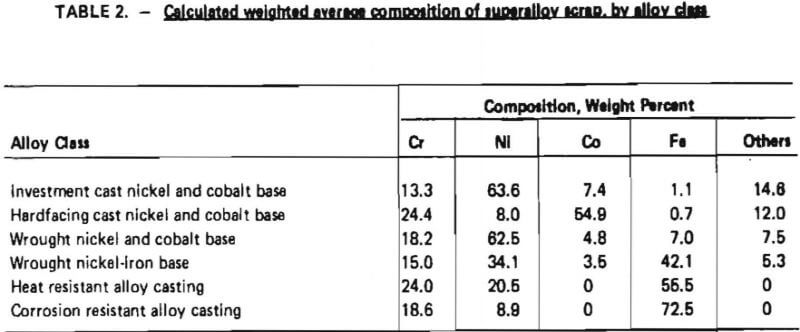
- Electrochemical or electrolytic processes in which an electric current is used as an aid in refining, dissolving or plating chemical species from solutions or melts; such as the work reported by Kenworthy and Nagai, et al.
- Hydrometallurigical processes based largely on wet chemical methods. Approaches include leaching with hydrochloric acid or chlorine, ammonia leaching, and caustic fusion followed by leaching.
- Miscellaneous techniques not easily classified, such as removing nickel from superalloys by nickel carbonyl.
Selected Approach
After giving due consideration to various approaches, a pyrometallurgical oxidation-reduction approach was chosen because of:
- technical soundness,
- limited number of process steps,
- energy efficiency,
- environmental soundness, and
- simplicity: chromium is separated from the major superalloy constituents early in the process; recovery of other elements is potentially feasible.
Kenworthy demonstrated it is feasible to separate chromium from nickel and cobalt in superalloy scrap by selective oxidation of chromium into a chromia-rich slag. His experiments showed that it was possible to oxidize chromium, columbium (niobium) and some of the iron into the slag phase while retaining nickel, cobalt, and residual iron in the metallic phase.
Kenworthy’s results would be expected from thermodynamic considerations. Figure 1 shows the relative oxygen affinities for many important constituents of superalloy scrap. As indicated, the tendency for nickel, cobalt, and iron to combine with oxygen is less than that of chromium. Given a sufficiently high oxygen partial pressure and neglecting activity coefficients, one would expect chromium to be oxidized out of a molten bath of superalloy scrap prior to the removal of nickel, cobalt, and iron under equilibrium conditions. Furthermore, these thermodynamic data show that by carefully controlling oxygen partial pressure, oxidation of cobalt, nickel, and iron could be prevented completely, while providing a chromium-bearing slag phase.
The chromium-rich slag phase could be considered a chromite ore suitable for subsequent smelting to produce high- or low-carbon ferrochromium. After separation from chromium-depleted metal, the molten slag phase could be reduced by a variety of means, such as with: (1) ferrosilicon, (2) scrap aluminum, or (3) carbon.
Barnard and Filar have shown that ferrosilicon reduction will easily recover over 90% of the chromium in the slag. Furthermore, ferrosilicon reduction has been commonly used in stainless steel production to control chromium losses to the slag. Good slag-metal contact is necessary since chromium reduction from the slag appears to be diffusion-controlled as found by Filar. Again Figure 1 shows that, under equilibrium conditions, the silicon in ferrosilicon would be expected to reduce chromium but not aluminum or titanium.
Based on this previous work, it is proposed that chromium be recovered from the other major alloying elements in superalloy scrap, namely nickel, cobalt, and iron by the selective oxidation of chromium into a chromium-rich slag (as shown in Figure 2). After separating chromium-depleted metal from the slag, the second step of the process would involve slag reduction, wherein chromium oxide in the slag would be reduced with carbon, aluminum or ferrosilicon to produce a ferrochromium product.
With regard to ferrochromium, steelmakers have generally preferred high chromium to iron ratios. However, discussions with steelmakers indicate that they would consider using ferro-chromium with a Cr/Fe ratio of one. Similarly, discussions with scrap dealers indicate that they would consider purchases of any nickel-cobalt bearing alloys. Thus, outside of possible contamination of product ferrochromium by minor alloying elements present in superalloy scrap feedstocks and process economic considerations (issues which were beyond the scope of this investigation), there appear to be no major difficulties in marketing the products and by-products produced by this proposed process.
Experimental Program
The purpose of the experimental program was two-fold:
- Establish a flowsheet for a process capable of separating and recovering chromium from superalloy scrap.
- Obtain necessary data for the preliminary design of a demonstration pilot plant capable of treating an average of 100 pounds per hour of scrap to recover a minimum of 65% of the contained chromium in a state sufficiently pure to provide a marketable product.
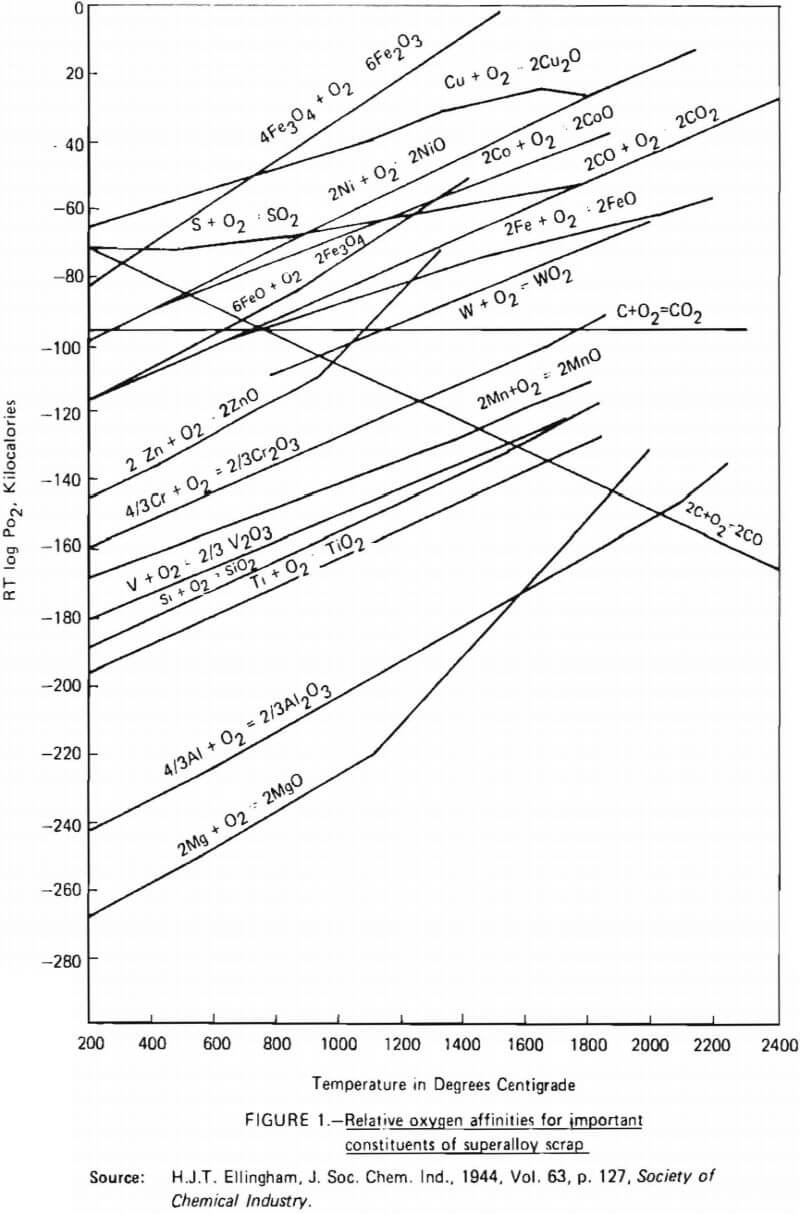

Key process steps needing demonstration are shown in Figure 3. Of these, the selective oxidation of chromium into a slag phase (Step 2) are reduction of chromium from a chromium-bearing slag into a metal phase (Step 4) are of particular importance. Hence, the main thrust of the experimental program was directed at verifying these two steps.
Metal Samples
Four types of superalloy scrap, listed in Table 3, were tested in this program. These types were selected because they represent each of the major types of superalloys currently being produced.
Samples of superalloy scrap were obtained from the INCO Research Center and a local scrap dealer. The samples were obtained as pieces in various physical configurations. In general, pieces weighed less than ¼ lb. Chips of metal were removed from each type of scrap and chemically analyzed to ensure the scrap’s identity. Chemical compositions are given in Table 3.
Scrap samples were not prepared in any special manner prior to being used. Large pieces were cut, as necessary, to fit within the furnace crucible. Gross surface impurities, such as dirt and grease, were removed by wiping. However, scrap pieces were not subjected to a complete chemical cleaning, such as washing with solvents or polishing.
In addition to superalloy scrap, several experiments were performed with low-cost AISI 430 stainless steel occasionally mixed with carbon steel. These metal samples, used to demonstrate the feasibility of chromium oxidation in the presence of large amounts of iron, were prepared in a similar manner to superalloy scrap samples.
Other Charge Materials
Besides metal samples, other materials charged to the furnaces included fluxing agents and reductants. Reagent grade silica and lime and NyCor Wollastanite (Interpace Corp.) were used as fluxes. Throughout the experimental program, a silica to lime ration of 2:1 (by weight) was used. Fluxes were prepared by mixing silica and lime or Wollastanite in the proper proportions followed by sintering in an open flame to produce pellets of about 1/8-¼ inch diameter. This was done to facilitate flux additions in the presence of a sweeping inert gas. Later in the program, powdered fluxes were simply poured onto molten baths without prior sintering when it was found that losses caused by the sweeping gas were insignificant.
Three kinds of reductants were tested for reducing chromium from chromium oxide-bearing slags: aluminum, carbon, and ferrosilicon. Aluminum and carbon were high purity materials in fine powdered form. Ferrosilicon pieces, also of high purity (75% silicon by weight), ranged from 1/8 to 1 inch in diameter. Reductants were either poured onto the surface of a molten slag layer or were mixed with a granulated slag followed by meltdown.
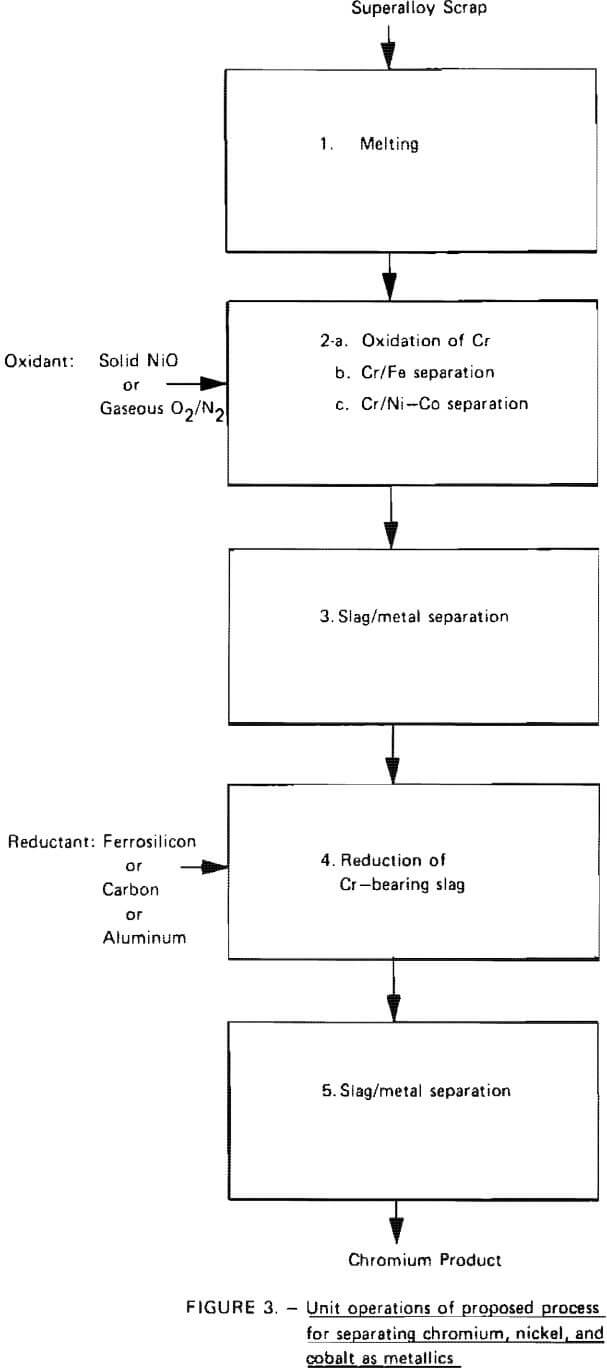

Apparatus
Two induction furnaces were used in the experimental program: a 50-kW furnace with a molten charge capacity of about 20 lb, and a 20-kW furnace with a capacity of less than one lb. The large furnace was used for both oxidation and reduction experiments, whereas the small furnace was used solely for reduction experiments.
50-kW Furnace
Figure 4 is a schematic representation of the crucible arrangement within the 50-kW induction furnace, which was powered by a variable frequency motor generator. As shown, a 12- inch diameter induction coil was coupled directly to the metal charge. The charge was contained in a magnesia crucible (approximately 4½” ID, 8″ high) which was placed within a fireclay crucible. A ½-inch thick graphite susceptor surrounded the inner crucible near its center to provide additional heat to the slag and prevent it from freezing. The space between the two crucibles was filled with alumina bubble insulation. The space between the induction coil and the outer crucible was packed with alumina ramming mix. Oxidizing gases (air and/or oxygen) were introduced either through a lance inserted through the top cover or through a single tuyere in the bottom of the furnace.
Initially, an airtight apparatus was desired to prevent metal oxidation during meltdown. To accomplish this, the rim of the inner crucible was machined to accommodate an asbestos gasket over which was placed a water-cooled brass plate. A one-inch thick ceramic fiber insulation blanket was placed below the brass plate, to serve as insulation as well as a radiation shield, pressure measurements, taken later in the program, indicated a positive pressure within the crucible during the injection of inert or oxidizing gases, Hence an airtight apparatus was unnecessary and a cover, fabricated out of castable refractory material, was used in all successive experiments. A schematic diagram of the castable refractory (ceramic) cover is shown in Figure 5. A photograph of the ceramic cover in the place above the crucible is given in Figure 6. For insulation a 11-inch asbestos layer was used with the ceramic cover rather than the ceramic Fiber blanket.
Both ceramic and brass tops had provisions for a sampler tube, off-gas exit tube, a port for pressure measurement, and a thermocouple well. For top-blowing oxidation experiments, an inert gas inlet and an oxidizing gas inlet were provided. These ports were unnecessary (and therefore sealed off) for bottom-blowing experiments since oxidizing and inert gases were injected into the bottom of the inner crucible.
The apparatus was instrumented as follows. Temperature measurements were taken with a platinum/platinum-rhodiura thermocouple placed above the melt. These measurements were
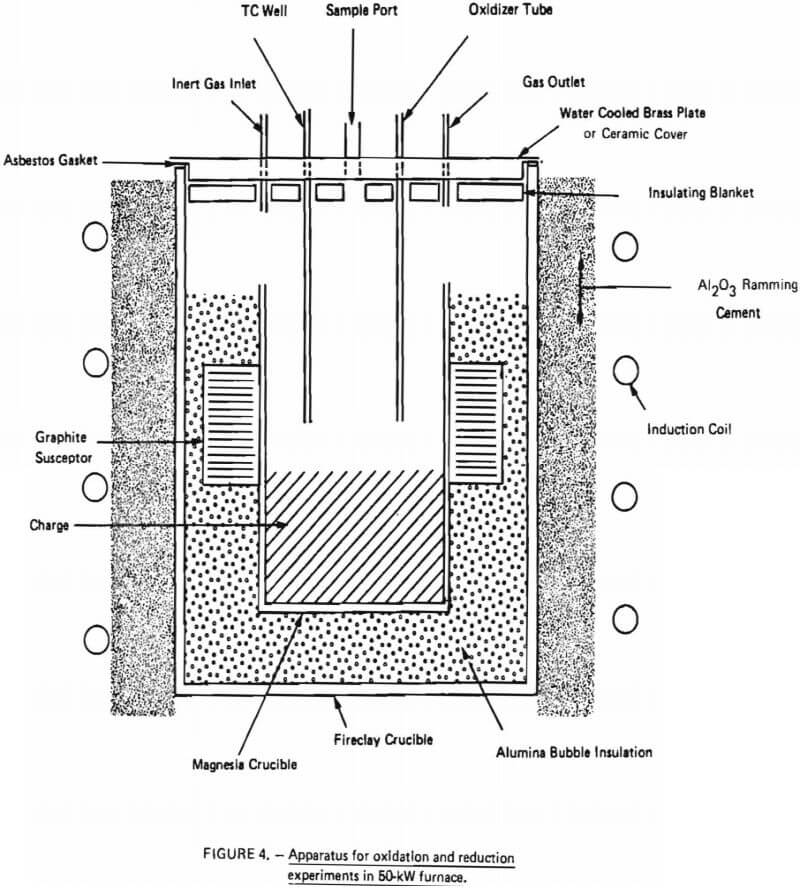
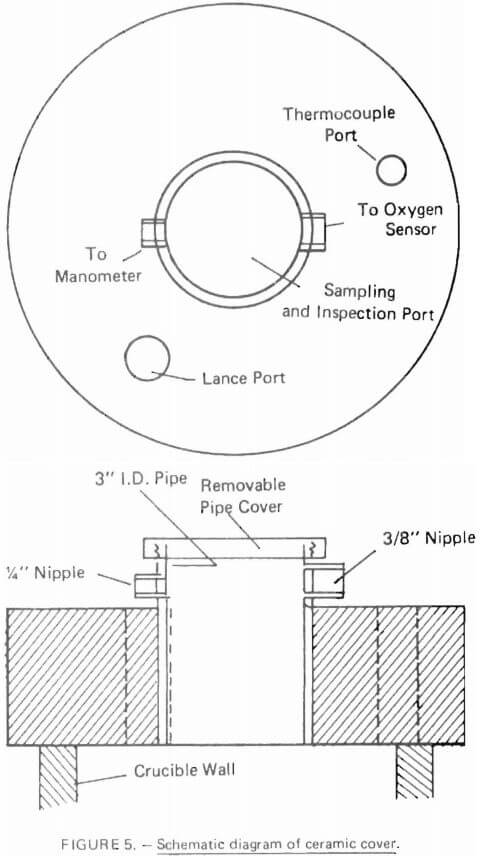
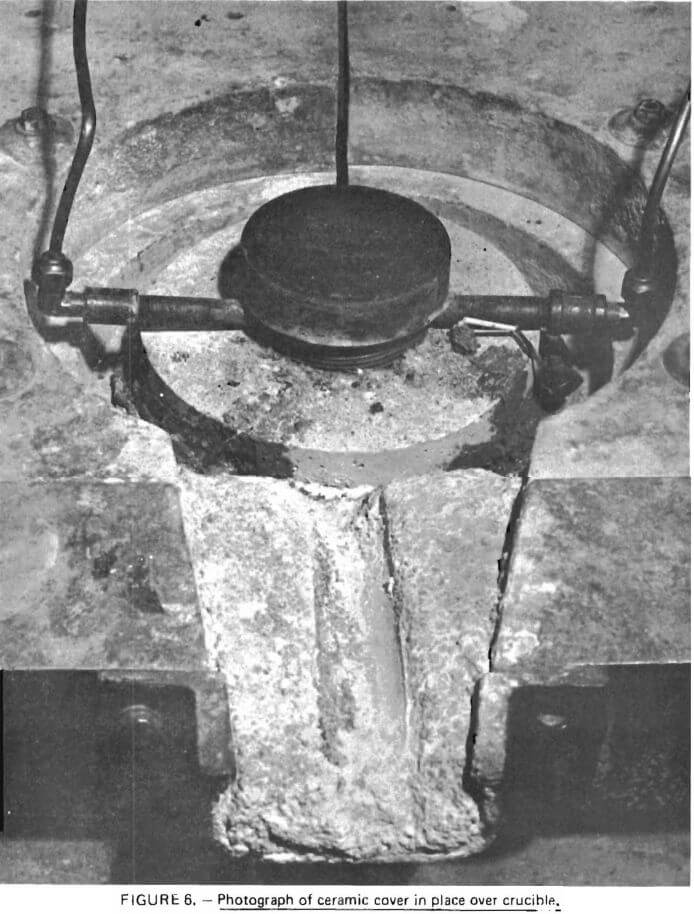
supplmented by optical pyrometer readings taken by sighting through the sampling port. The oxygen content of crucible off-gas was monitored on a periodic basis with an oxygen probe. The probe was a polargraphic instrument with a pinole diffusion barrier rather than a membrane to minimize temperature sensitivity. Gas pressure within the crucible was measured with a small-diameter liquid manometer. Gas injection rates into the crucible were measured with rotameters and pressure gauges.
The experimental apparatus for bottom blowing through a tuyere is of importance because it is rarely done on such a small scale. A schematic diagram of the tail-safe gas delivery system is shown in Figure 7. The system was designed so that a reasonable flow of gas could be maintained into the bottom of the crucible at all times. It consisted of two nitrogen tanks feeding into a single line, past a rotameter and a pressure regulating valve into a 3/16-inch ceramic tube which was rammed into the center of the crucible bottom. All gas lines were copper tubing with swaged fittings, except the line from the final pressure gauge to the ceramic tube, which was high-pressure rubber tubing. Compressed air, after passing through a rotameter, entered the feed line upstream of the pressure regulating valve. Compressed air was set at a slightly higher pressure than nitrogen so that once air was turned on, any nitrogen flow would be automatically stopped. Should the air flow be interrupted at any time, nitrogen would begin flowing instantaneously. Thus, the only way that gas flow could be completely stopped (which would instantly terminate an experiment by allowing molten metal to empty out of the crucible via the ceramic tube) would be if both nitrogen tanks emptied. Nitrogen was injected into the lines at approximately 36 psig, compressed air at 42 psig, and the pressure regulating valve was set to provide a gas flow at about 5 psig. As such, pressure fluctuations within the crucible did not disturb rotameter readings.
20-kW Furnace
The 20-kW induction furnace operated at radio frequencies to inductively heat a small-sized graphite shell (susceptor). The crucible arrangement, located within a stainless steel pressure chamber, is shown schematically in Figure 8. As indicated, a 3-inch diameter induction coil was coupled to a graphite susceptor. Inside the susceptor was a refractory crucible containing the charge (chromium oxide-bearing slag and reductant). Although some magnesia crucibles were used in these 20-kW furnace tests, the majority of reduction experiments were performed in alumina crucibles. A ceramic fiber blanket was placed between the susceptor and induction coil to serve as insulation as well as a radiation shield.
Method
Oxidation experiments were performed by top blowing oxidizing gases onto the surface of molten baths and by bottom blowing gases through the baths. The experimental procedure was identical for both cases. In addition, one oxidation experiment was performed by mixing known amount of solid nickel oxide and AISI 430 stainless steel which were charged to the 50-kW furnace. After meltdown, sufficient time was allowed for equilibration of the nickel oxide with chromium to produce chromium oxide and metallic nickel.
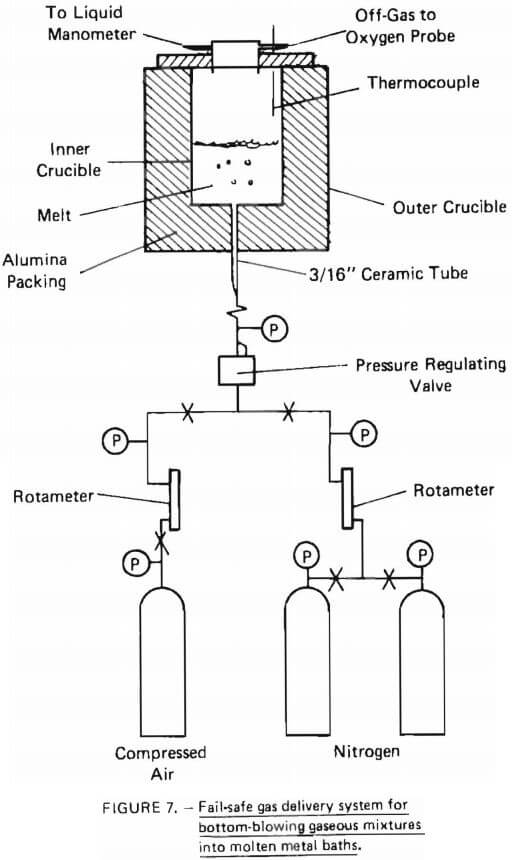
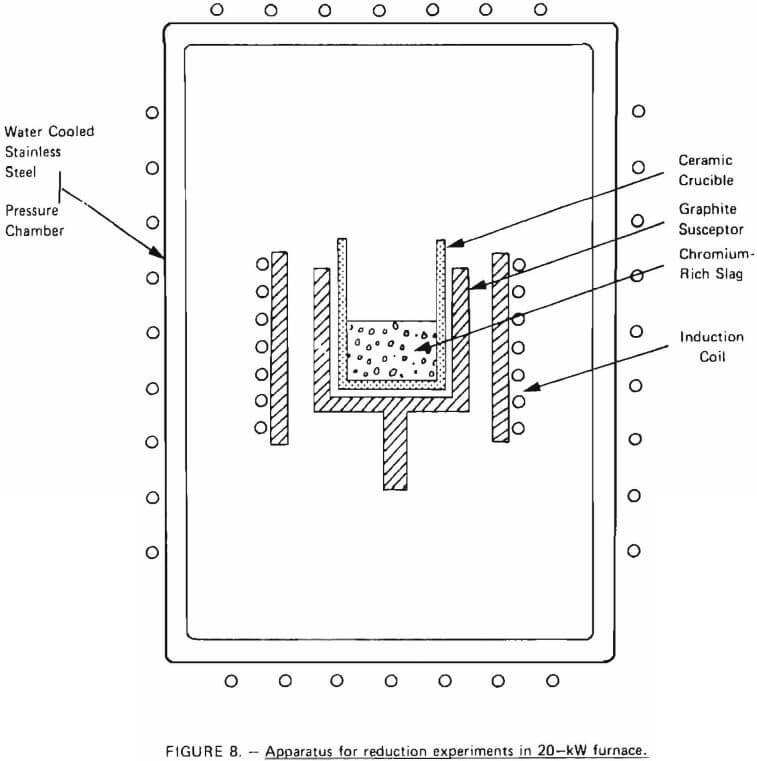
Reduction experiments were performed by adding the reductants onto the surface of chromium-bearing slags in the 50-kW furnace and by mixing reducing agents with synthetic solid chromium-bearing slags, followed by charging the mixture to the 20-kW furnace. The experimental procedure was somewhat different for these two cases. Detailed procedures for both oxidation and reduction experiments are described below.
Oxidation Experiments
Scrap samples were weighed and charged to the inner crucible. The asbestos gasket was placed over the flat rim of the outer crucible followed by a ceramic fiber insulation blanket and the water-cooled brass lid, or simply the ceramic cover. To prevent off-gas leakage around the ceramic cover, the cover was sealed in place with castable refractory material, which was allowed several hours to completely cure. The thermocouple was placed in the thermocouple well, and gas connections and water connections (if necessary) were made.
The crucible was sufficiently purged with inert gas to ensure that oxygen would not be present during meltdown. Three kinds of inert gas were used: nitrogen, argon and an argon-5%, hydrogen mixture. Inert gas was allowed to flow throughout the meltdown period. Furnace power was turned on at about 3 kW. Temperature measurements were taken as the charge heated. Power settings were increased every 15-20 minutes up to a setting of 12-14 kW when meltdown was achieved. This prolonged melt procedure was followed to reduce thermal shocks to the ceramic crucible.
Once the charge was completely molten, large thin pieces of scrap were added through the sampling port as necessary. Following the meltdown of this material, the bath was allowed to stand for about 15 minutes with the power at a reduced level. A sample of the melt was then taken.
Samples were taken by two methods. In general, a sampling tube, consisting of a 3mm ID, thick-walled quartz tube, with a rubber squeeze bulb, was used. With the bulb in the deflated position the tube was quickly lowered into the bath. Pressure on the squeeze bulb was released, drawing molten metal into the tube. The sample was then quenched in cold water, causing the quartz tube to break off. Alternatively, samples were taken by dipping a piece of stainless steel flat stock, bent at 90° near its end, into the melt. Portions of the bath froze to the bar, which was then removed from the crucible. After quenching, the sample was removed from the bar by a sharp blow with a hammer. Metal samples were obtained with both methods; slag samples could be taken only with the latter. All samples were chemically analyzed for weight percent chromium, cobalt, nickel, and iron. A description of analytical techniques is given in Appendix A.
In general, metal samples obtained by the above methods were reasonable; that is to say chemical analyses of metal samples showed reproducible patterns with oxidation or reduction equilibration time. However, the reliability of slag samples was questionable. This appeared to be due to the difficulty of obtaining slag samples that were not contaminated with metal phase. Because of the highly viscous and, at times, almost frozen nature of slags within the 50-kW induction furnace, it was extremely difficult to sample only the slag phase. To alleviate this problem, a graphite susceptor was installed to provide additional heating on the premise that a less viscous slag would simplify sampling procedures. However, it was found that the susceptor did not provide sufficient heat to guarantee liquid slags, Hence, chromium oxidation was followed by tracking the chromium content of metal samples. Selected slag samples were used to verify the results.
After the initial sample was taken, flux was added and allowed to melt. Inert gas flow was terminated and oxidizing gas flow begun. Periodically during the blow, metal and slag samples were taken, bath temperature monitored, and oxygen utilization determined. Power adjustments were made as necessary to hold the bath at about 1600°C. During certain experiments, additional flux additions were made to provide a more fluid slag. Once the desired amount of oxygen had been injected into the crucible, either by top or bottom blowing, gas flow was switched over to inert gas, and the melt was allowed to stand for 15-30 minutes, after which the final metal sample was taken. The melt was then either cast (by pouring into a sand mold) or left to cool in the vessel. Alternatively, the melt was used as starting material for a reduction experiment.
Reduction Experiments
The experimental procedure for reduction experiments performed in the 50-kW furnace was to add a weighed amount of reductant (graphite, ferrosilicon, or aluminum) onto the surface of a molten chromium-bearing slag. The slag and associated metal phase had been produced during an oxidation experiment. Samples of both were taken prior to the addition of reducing agents.
In general, the effect of reductant on the system was rapid. Samples of the metal and slag phases were taken periodically up to one hour after addition of reductant. After a final set of samples was obtained, the melt was cast. Throughout the experiment, the crucible was purged with inert gas. Bath temperature was monitored with optical pyrometer readings and power adjustments were made as necessary. As with oxidation experiments, an attempt was made to keep the bath as close to 1600°C as possible. Actual temperature readings ranged from 1550- 1650°C.
The experimental procedure for reduction experiments performed in the 20-kW furnace was as follows. The charge, consisting of chromium oxide, lime-silica flux, and reductant, and the crucible were weighed. The charge was transferred to the crucible which was placed within the graphite susceptor. The porta on the stainless steel enclosure were sealed and the cavity filled with inert gas. The power was then turned on. Temperature measurements were made with an optical pyrometer. The charge was allowed to melt and held molten for periods of time ranging from 15 to 45 minutes after which power was shut off. After the crucible had cooled, the contents were removed, and metal and slag portions were separated, weighed, and sent for analysis.
Results and Discussions
Experiments were designed to verify the technical feasibility of major process steps and to provide basic engineering data for the preliminary design of a pilot plant, Experimental results are therefore presented according to major process steps in this process. As stated previously, since oxidation of chromium and its subsequent reduction represent critical steps, the main thrust of the experimental program was directed at these two steps.
Scrap Melting
Open arc electrical furnaces have been widely used for scrap melting in carbon and stainless steel industrial practice. In this experimental program, an induction furnace was utilized since it is difficult to undertake open-arc-furnace testing for scrap melting and partial oxidation on a laboratory scale.
The results of scrap melting experiments, performed as a necessary preliminary to oxidation experiments, indicated that the packing density of the scrap charge largely determines the ease with which melting can be achieved. Thin sections of WI-52 and B-1900 superalloy scrap, loosely packed inside the crucible, could not be melted. However, if the scrap was cut and pressed into compact pieces to achieve high packing densities, satisfactory melting could be achieved. Furthermore, melting times could be significantly reduced by adding scrap to a molten heel. This result is consistent with industrial electric arc furnace operations.
The experimental results pertaining to melting are not directly applicable to pilot-plant design since an electric arc furnace was selected for pilot-plant experimentation. Discussions with steel makers and electric arc furnace suppliers indicate that no unusual technical problems associated with scrap melting should arise.
Chromium Oxidation
Oxidation experiments were performed by top blowing oxidizing gases (mixtures of oxygen and nitrogen) onto the surface of molten metal baths, and by bottom blowing compressed air through molten baths. Bottom-blowing experiments were performed in order to demonstrate whether better oxygen utilization could be achieved then with top-blowing experiments. A total of forty-two oxidation experiments were performed. Typical results are presented for these experiments in terms of:
- chromium recovery;
- distribution of principal alloying elements.
separation between chromium and iron;
separation between chromium and cobalt and nickel;
separation between chromium and other alloying agents, such as titanium, tungsten and tantalum; and - oxygen utilization.
Chromium Recovery
Experimental results showed that given sufficient oxygen the chromium content of a molten bath of superalloy scrap could be reduced almost quantitatively to zero. Indicative of this are the results obtained by top blowing oxygen-nitrogen mixtures onto the surface of a molten bath of B- 1900 and Inconel 600 superalloy scrap initially containing 12.2% chromium. In this experiment, the chromium content of the metal phase was reduced from 12.2% to 0.003% in a period of about three hours, using gaseous mixtures consisting of either 1) 50% oxygen and 50% nitrogen (by volume) or 2) pure oxygen. The bath temperature ranged from 1530 to 1700°C. An overall material balance for this particular experiment is given in Table 4. Chemical analyses of metal samples obtained during the run are given in Table 5, and the chromium to nickel ratio in metal samples as a function of oxidation time is given in Figure 9. Also shown in Figure 9 are injection rates ad gas composition for oxidizing gases.
A material balance for this experiment, shown in Table 6, was calculated based on:
- initial weight of superalloy scrap charged to the crucible.
- chemical analysis before oxidation of molten metal (Sample 24-1M) for iron, chromium, nickel, cobalt, and “other” elements calculated by difference, and
- Final chemical analysis (at the end of the oxidation experiment) of metal phase (Sample 24-8M) for the elements listed above.
The approach used in constructing the material balance assumed that nickel and cobalt remained in the melt phase (that is, were not oxidized) and that chromium, iron, and “other” species were partially removed by oxidation. The oxygen content of the slag was estimated by assuming that chromium oxidized to Cr2O3 iron to FeO and “others” to MoO2, TaO2, Al2O3 and TiO2. The “other” category was partitioned into molybdenum, tantalum, aluminum and titanium based upon the nominal compositions of Inconel 600 and B-1900 superalloys as given by Inco.
The material balance, given in Table 6, shows that the computed output of 3906 grams compares well with the experimental weight of 3997 grams. (The experimental weight was known to be higher than the true value because of difficulties in removing some alumina particles from the metal ingot.) In addition, the calculated concentrations of elements in the metal phase compare well with measured values, as shown in Table 7.
Based on the results of the material balance given in Table 6, the chromium removal for this oxidation experiment was greater than 99.9%.
To illustrate high chromium removal with a different metal composition, a charge consisting of about equal weights (6526 grams total) of AISI 430 stainless steel and carbon steel was top-blown with a 50% oxygen-50% nitrogen gas mixture. Lime-silica flux was added at 1.7% by weight of metal charge. Metal samples were taken periodically during the run. Compositions are given in Table 8. Readings taken with a Pt-PtRn thermocouple placed above the bath, indicated that the temperature of the bath ranged from 1300° to 1420°C with an average of about 1375°C. These temperatures indicate an average bath temperature of approximately 1525°C, slightly lower than normally used in oxidation experiments.
Figure 10 presents a plot of chromium content of the bath as a function of oxidation time. During this run, the chromium content of the metal was reduced from 7.6% to 0.11%. Based on the assumption that nickel and cobalt were not oxidized (justifiable from slag analyses) a final metal weight of 4487 grams was estimated. The chromium removal was therefore 99.1%.
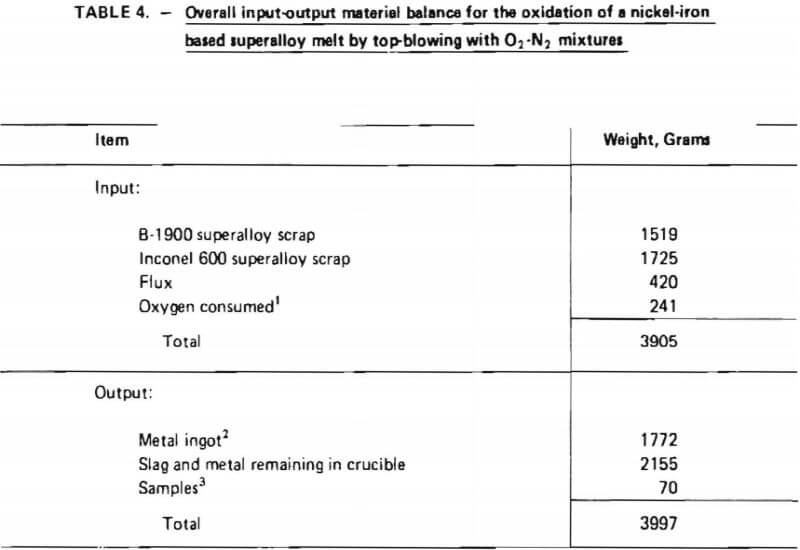
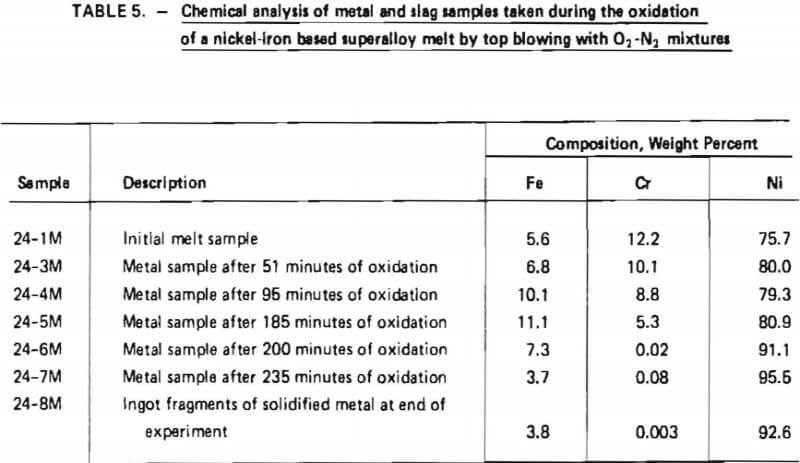


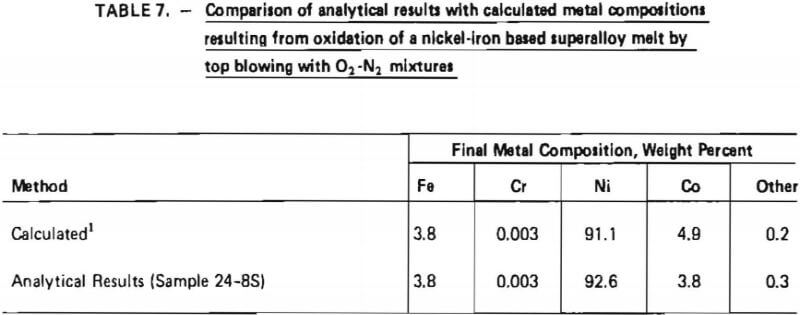
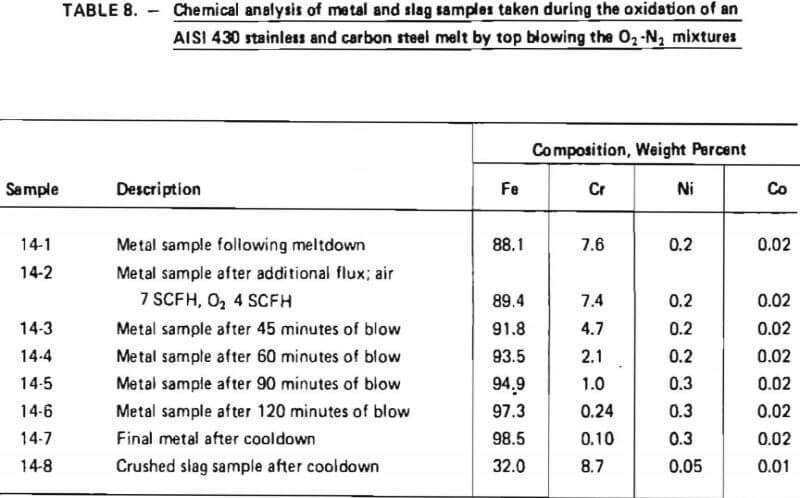
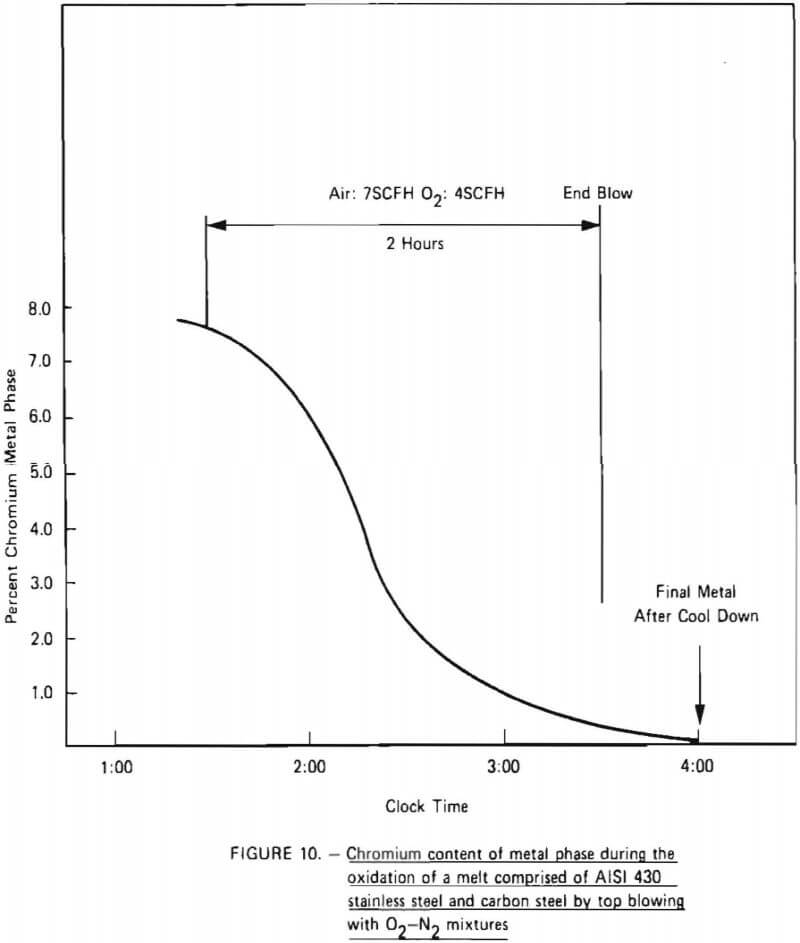
In an example of an experiment illustrating the use of a gaseous oxidant starting with AISI 430 stainless steel and carbon steel, the chromium content of the metal phase was reduced from 3.1% to 0.3% in 80 minutes using a top-blown mixture of 50% oxygen and 50% nitrogen. The overall material balance and chemical analyses of samples for this experiment are given in Tables 9 and 10, respectively. Temperatures within the crucible average 1660°C during the run. Based on the estimated weight of metal in the crucible at the end of the experiment, and final chemical analyses, chromium removal was 92.1%.
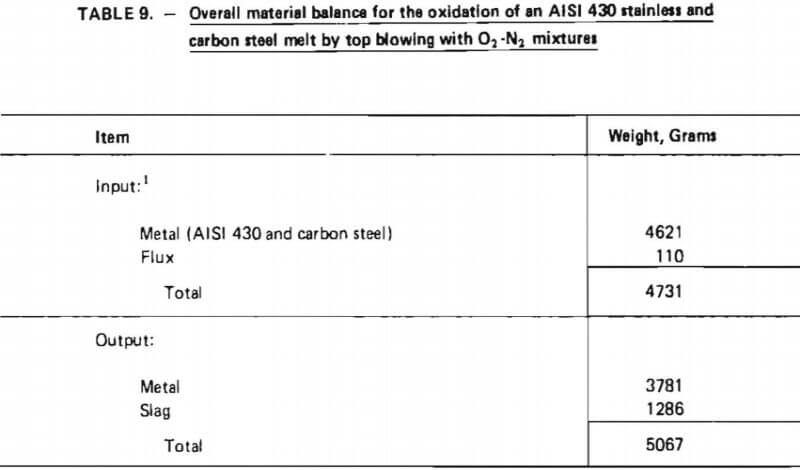

From thermodynamic considerations, any nickel inadvertently oxidized should be capable of oxidizing residual chromium in the metal phase (Figure 1) by the following reaction:
3NiO + 2Cr → Cr2O3 + 3Ni
To demonstrate that this would occur a charge consisting of 1230 gms of AISI 430 stainless steel analyzing 14.4% chromium and 493 gms of nickel oxide was melted and allowed to equilibrate for an hour in an inert atmosphere. The amount of nickel oxide used was in excess of that required for chromium oxidation. After equilibration the power was turned off and, following cooldown, weights of metal and oxide phases were estimated and samples of metal and oxide analyzed. A total material balance is shown in Table 11. The compositions of the metal phase before and after equilibration and the oxide phase after equilibration are shown in Table 12. As indicated the chromium content of the metal phase was reduced from 14.4 to 0.1%. Based on the weights of metal and composition of the metal phase before and after equilibration, chromium removal was estimated to be 99.2%.
Table 13, summarizing the oxidation experiments, shows that removals of chromium in excess of 99% can be achieved.
Distribution of Principal Elements
Table 14 summarizes the distribution of principal alloying elements in oxidation experiments. These results were calculated from analytical results of metal samples prior to oxidation and the computed composition of the metal phase after oxidation, as specified by material balance calculations (for example, see Table 6). The separation between chromium and the principal alloying elements is discussed below.
Separation Between Chromium and Iron
An examination of the data in Table 14 indicates that:
- A significant amount of iron was oxidized into the slap phase during top blowing especially when the initial metal weights ratios, Fe/Cr were fairly large.
- Even with significant quantities of iron oxidation occurring with top blowing, slags were obtained with Cr/Fe ratios exceeding 1.0.
- Comparison of top-blowing and bottom-blowing experiments for melts having similar levels of chromium indicate that with bottom blowing chromium can be oxidized with little or no iron oxidation.
In the induction furnace tests having cold and rather viscous slags, gas-metal contact with top blowing appeared to be poor. Gas-metal contact was excellent with bottom blowing. Thus, bottom blowing offers an interesting alternative for achieving chromium oxidation while preventing iron oxidation.
Separation Between Chromium & Cobalt & Nickel
Analysis of the slag phase from various oxidation experiments indicated low levels of nickel and cobalt. Material balance calculations, assuming all nickel and cobalt stayed in the metal phase, gave weights of slag and metal phase that compared well with experimentally determined weights, Analytical data thus confirm theoretical free energy considerations (see Figure 1) that nickel and cobalt remain in the residual metal phase during chromium oxidation.
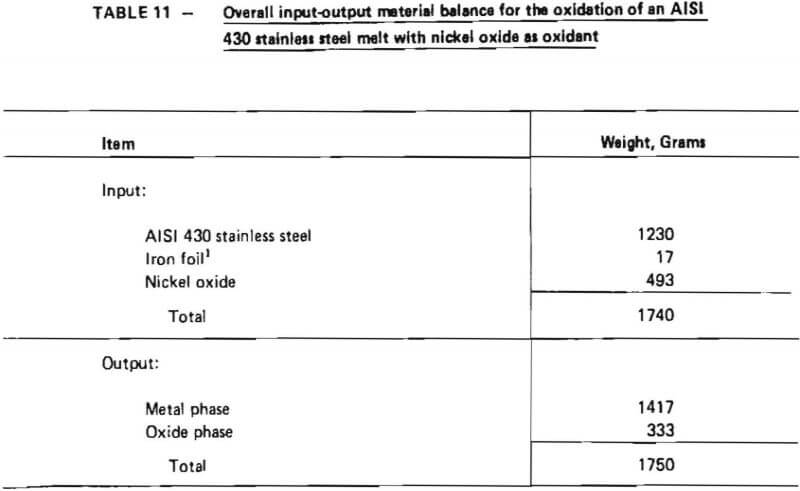

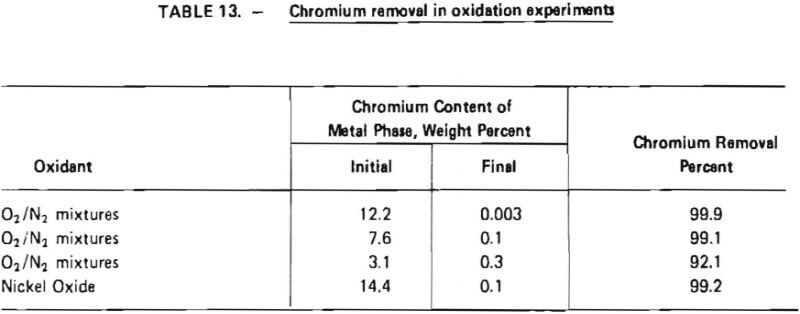

Separation Between Chromium & Alloying Elements
In the present experimental program the total amount of other alloying elements (such as titanium, tungsten, and tantalum) was analyzed by difference. It is seen from Table 14 that these elements exhibit a tendency to concentrate in the slag phase. This results was to be expected as many of the elements are more oxidizable than chromium, that is, the Ellingham diagram (Figure 1) indicates that these elements have more negative free energy of oxide formation than does chromium.
It must be noted that actual concentration of minor alloying elements in the metal and slag phases were not determined in this investigation. Although the oxidation and subsequent reduction of chromium was studied in the presence of these minor alloying elements, the determination of the distribution of these elements between slag and metal phases during oxidation and reduction was deemed outside of the scope of this project. Since the purity of ferrochromium product is dependent on the extent to which these elements are present, report to the slag during oxidation and are then reduced into the ferrochromium during reduction, it is important that this issue be studied in later pilot-plant investigations when specific types of scrap available to this process become more clearly delineated.
Oxygen Utilization
During oxidation experiments, a polarographic-type oxygen sensor was used on line to measure the oxygen content of off-gases. Since pressure measurements made in the system indicated a positive gauge pressure, oxygen sensor measurements were interpreted as being representative of off-gases leaving the crucible.
In top-blowing experiments with oxygen-nitrogen mixtures, oxygen utilization was a function of the amount of slag in the system. Typically with very little slag, oxygen utilization would be high (about 100%) and drop off to low values (less than 20%) as slag crusting occurred. Physically breaking the slag crust would cause oxygen utilization to increase because fresh metal surface was exposed to the oxidizing gas.
In bottom-blowing experiments with air, oxygen utilization was high, in excess of 95%.
Slag/Metal Separation
Several experiments were performed in which attempts were made to remove chromium-bearing slags from the crucible (in the 50-kW furnace) while retaining molten metal, that is, to perform a high temperature separation of slag and metal phases. Since the induction furnace was not equipped with a slag gate for pouring, attempts were made with various kinds of scoops. In general, these attempts were unsuccessful — at best less than 20 percent of the slag could be removed with the scoop. However, there were some indications that a higher ratio of silica:lime than 2:1 (as used in most oxidation fluxes) improved slag fluidity and by extension the ease by which slags could be removed. The optimal acid/base ratio for slag fluidity could not be determined from these tests.
Reduction of Chromium-Bearing Slags
The purpose of the reduction experiments in the present experimental program was to demonstrate that chromium could be reduced from slags obtained by the oxidation of superalloy melts. Accordingly, raw materials were chosen to simulate materials that would be obtained in pilot-plant testing. In the oxidation experiments of the present experimental program, slags containing 20-30% chromium and Cr/Fe ratios in excess of 1.7 were obtained, as shown in Table 15. These slags are similar in composition to slags obtained in a pilot-scale test to produce ferrochromium from iron-rich chromites. For example, as described in reference 5, a lime-chromite slag containing 20% chromium was produced using iron-rich chromite with a Cr/Fe ratio of 1.6. This slag was reduced with ferrosilicon (75% Si) to produce ferrochromium with a chromium yield exceeding 85%. For chromites with higher Cr/Fe ratios the reduction step has been demonstrated by industrial ferroalloy practice.

Reduction with Ferrosilicon
In the present experimental program, the reduction of synthetic chromium-bearing slags with ferrosilicon was carried out in the 20-kW induction furnace in 2″ alumina crucibles. These experiments showed that chromium can be reduced from synthetic slags containing as little as 10.3% chromium with ferrosilicon to produce a product rich in chromium (65.3% Cr) at high chromium recoveries exceeding 95%.
Further confirmation was obtained of being able to reduce the chromium from slags produced by oxidation of superalloy and stainless steel melts using the 60-kW induction furnace. The experiments consisted of addition of ferrosilicon (75% Si) to a molten bath of chromium-bearing slag covering residual metal from an oxidation experiment. As the reduction proceeded, the chromium content of the residual metal phase increased. The reduction was followed by means of metal samples taken for analysis during the experiment.
For example, slag obtained from the oxidation of an iron-nickel based superalloy was reduced with 75% ferrosilicon to recover over 95% of the chromium from the slag. At the start of the experiment the slag analyzed 30% Cr and the residual metal phase analyzed 8.9% Cr. The bath temperature was maintained between 1525° and 1575°C during the experiment.
In order to reduce the chromium into the slag phase, 200 grams of ferrosilicon was initally added to the bath. After 40 minutes of equilibration, another 50 grams of Fe-Si was added.
Samples of metal phase were taken during the experiment and a slag sample towards the end of the experiment. An overall input-output balance for this experiment is shown in Table 16. Chemical analyses of metal and slag samples obtained during the experiment are shown in Table 17.
A material balance for this experiment, shown in Table 18, was calculated based on estimated weights of slag and metal initially present in the crucible, the composition of metal as given by sample M7 and an estimated slag composition S1. It was assumed that chromium and ‘other’ metallic elements were reduced from the slap phase into the metal phase by reaction with free silicon present in ferrosilicon. Since silicon analyses were not performed, the efficiency of silicon use could not be investigated. As shown in Table 19, the final compositions of the slag and metal phase agree well with measured compositions. The chromium recovery based on the material balance was 95%.
Reduction with other Reducing Agents
Preliminary test work was done with aluminum and carbon as reducing agents on slags obtained from oxidation experiments of cobalt-based superalloy. Results indicate that, as expected, aluminum and carbon can be used as reducing agents for chromium oxide.
https://www.911metallurgist.com/pyrometallurgy-chrome-recovery-plant-design/
